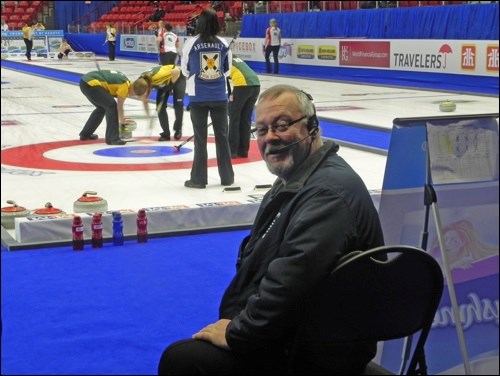There were those of us who watched the Scotties regularly on TV as it played out Feb. 14 to 22 in Moose Jaw. There were those of us who had the privilege of attending in person to watch some or all of the draws at this Canadian women’s curling championship. And, there was one Wilkie resident who attended the entire Scotties event, only in a manner unfamiliar to many of us.
He doesn’t wear referee stripes and he doesn’t blow a whistle but Kevin Glessing of Wilkie was part of the officiating crew all week long. Al Cameron, director of Communications and Media relations of the Canadian Curling Association tell says, “To be a national umpire, Kevin would need to have his Level 3 National Officiating Certification Program certificate. Kevin was recommended to the CCA by CurlSask in 2012, and his first event for the CCA was the 2012 Canada Cup here in Moose Jaw.”
While watching the draws at this event you could see the mileage Glessing put on during his shifts. He spent plenty of time walking the length of the rink overseeing the scorekeepers and other officials. With a headset on, he kept in contact with all other officials to ensure time outs and any problems that arose during that draw were being managed. All the while he appeared relaxed as well as enjoying himself.
Danny Lamoureux, director of Curling Club Development and Championship Services for the Canadian Curling Association answers the question, “What does a game umpire do?”
“The game umpire manages the game by observing for any infractions, to be on hand for any team concerns such as an electronic handle not operating, to perform any measures and to co-ordinate with the TV production,” Lamoureux says.
“Game umpires also need to manage time outs and supervise pre-game practices and warm ups. There is a game umpire on each sheet of ice.
Following his return home from the tournament, Glessing said he started officiating 15 years ago.
“I often attended curling as a spectator and one tankard I attended I knew one of the officials and he asked me if I wanted to try it. I knew I wasn’t going to get to one of these events as a curler, so I decided this was a way to get in the action as well as a way to give back to the game.”
This was Glessing’s first Scotties event and he had known since August that he would be part of the officiating crew at this event.
To officiate at the national level, Glessing says officials must first take a level one course, which takes about five hours of instruction, along with working six games as an observer or a timer. Then level 2 must be completed with another five hours of instruction and another six draws to work at. After these levels are complete, an official moves on to level three and that comes from recommendations from head office at Curl Sask.
Glessing has a long list of officiating credentials including the Sask. Tankard in Melville this year. Past Canadian curling events Glessing has been a part of the officiating team for were the 2014 Canada Cup in Camrose, Alta. as well as the Canada Cup in Moose Jaw in 2012. He has also served as an official at junior nationals, senior nationals in Prince Albert, northern playdowns, provincial playdowns, masters championships and others.
The chief umpire makes a rotating schedule for officials and there may be a draw or two off and some days officials might be at the rink steady from 8 a.m.t o 10:30 p.m.
Officials at these events are not paid for their work but their expenses are reimbursed for food and accommodations. Their work is on a volunteer basis. The work can be cold and lonely and make for some long days but the benefits far outweigh any downfalls that there may be.
Glessing says some of the biggest rewards are meeting the players at the events and having fun with them during pre-game events.
“I’ve definitely got the best seat in the house for all the action!”
Glessing adds, “ I have also received acknowledgment from players who come by and thank you for your work so you know what you’ve done is valued.”
Glessing recommends this job to others who enjoy the sport of curling. It’s easy to start with level one by registering with Amber Holland at the Curl Sask office. Glessing himself has offered a clinic in Unity in the past.
As for this year, he is done working Canadian Curling Association events but he is on the officiating team for provincial masters upcoming in Kindersley as well as the mixed provincials upcoming in North Battleford.



